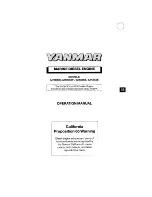
Jabiru Aircraft
Pty Ltd
Installation Manual
Jabiru 3300 Aircraft Engine
REVISION
0
1
2
3
4
5
6
7
Dated : 1
st
Dec 2016
Page: 46 of 56
12.3
Air Inlet & Ram Air Ducts
The engine should be installed using RAM AIR ducts provided with the engine. The ducts themselves are to
be assembled as detailed in Section 12.3.1.
The ram air ducts are screwed to the engine using the normal rocker cover screws. Note that if the duct is
not fastened to the engine then air pressure at high speed can lift the ducts off the engine. This will upset
the pressure balance inside the cowl and impede cooling. More importantly, with some types of ducts, the
duct lifting will dislodge the spark plug high tension leads, causing the engine to run roughly or stop.
For best cooling on the ground, during climb and low speed flight the propeller used must have significant
pitch and blade area on the section immediately in front of the air inlets. At low speeds the airflow does not
have much energy, and the acceleration and pressure provided by the propeller greatly assists in getting air
into the ram air ducts.
Each duct must have a 25mm hole at the inside top front to bleed air over the crankcase.
The pressure differential between the inside the cooling ducts and the cowl outlet must not be lower than
60mm (2.4
”) water gauge at when the aircraft’s speed is 1.3 times the stall speed (1.3 x V
S
).
The cooling ducts provided are a starting point in establishing effective engine cooling. The ducts may
require to be increased in size and additional baffles provided for best cooling.
Tubes of approximately 12mm diameter are required to provide cooling air to the ignition coils - Figure 51.
For an air cooled engine it is entirely normal for there to be significant differences in the temperature of each
cylinder head. Often the head which is hottest in the climb will not be the hottest during cruise & descent.
This is only a problem if the hotter heads exceed the engine’s set limits.
“Gull Wing” baffles can be used to fine-tune the restriction to airflow caused by the engine, and this in turn
affects the volume of air flowing through the engine and into the cowls. Fitting the baffles will give a higher
restriction as it forces air to flow through the small gaps between fins. Leaving the baffles out provides
larger gaps
– and a higher volume of relatively cool air blows through these gaps into the “Hot” zone
immediately under the cylinder heads. Wherever possible it is recommended to leave the baffles out.
However, compared to an installation with the Gull Wings fitted, a significantly larger volume of air must be
sucked out of the cowl outlet. This often requires a larger cowl outlet or a larger lip on the existing outlet.
Pressure differentials must be maintained.
Check for contact of engine, cooler or ducts on cowl. Any contact will cause excessive vibration & if the oil
cooler is rubbing it will eventually fail & leak.
Figure 50. Front-On View Into Ram Air Duct
Hole in ram air duct to blow
cool air over the crankcase
Front baffle in duct to
prevent air slipping
under cylinder & head
Rear baffle to direct air
into rear cylinder head











































